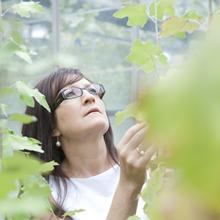New research suggests delay in autumn colour is caused by increased atmospheric CO2 not global warming
The delay in autumnal leaf coloration and leaf fall in trees is caused by rising levels of carbon dioxide (CO2) in the atmosphere and not by increased global temperatures, suggests a new study by researchers at the University of Southampton.
In recent years, woodland autumnal colour changes have been occurring later in the season whilst re-greening in spring has been occurring earlier. During the last 30 years across Europe, autumnal senescence – the process of plant aging where leaves discolour and then fall – has been delayed by 1.3 - 1.8 days a decade. To date, this has been explained by global warming, with increasing temperatures causing longer growing seasons.
However, while a strong correlation has been observed between increased global temperatures and earlier spring re-greening and bud break, the correlation between autumn leaf colour change and fall and temperature trends in 14 European countries is weak.
Over the 30 years that progressive delays in autumnal senescence have been observed, atmospheric CO2 has risen by 13.5 per cent. Experimental studies show that increased atmospheric CO2 affects plant physiology and function, influencing a myriad of processes.
The Southampton researchers undertook two large forest ecosystem experiments in which poplar (Populus) trees in separate plots were exposed to either ambient or elevated levels of CO2 from planting to maturity. The elevated concentration was at 550 parts per million, proposed as representative of concentrations that may occur in 2050. Changes in the tree canopy were measured by remote sensing.
The trees exposed to elevated CO2 retained their leaves for longer and also experienced a smaller decline in end of season chlorophyll content, resulting in a greener autumn canopy relative to that in ambient CO2.
Professor Gail Taylor, of the University’s School of Biological Sciences, explains:
"The research data provide compelling evidence in terms of both the leaf and canopy that autumnal senescence in such forest ecosystems will be delayed as the atmospheric concentration of CO2 continues to rise, independent of increased temperatures.
"Photosynthesis and canopy greenness are maintained for longer in elevated CO2. This is because a CO2 rich atmosphere allows the tree to generate carbon rich compounds that are known to prolong the life of leaves. These compounds may have a positive effect for carbon balance and stress tolerance but may also have a negative effect on the control of dormancy.
"When trees keep their leaves for longer, they continue to photosynthesise but trees also need to set bud and if they don’t do that, it makes them susceptible to frost and other weather events. A key question now is whether we should be selecting trees which are better adapted to coping with increasing levels of CO2, perhaps considering different varieties and species to plant, rather than using locally sourced seed, as is current practice," she continues.
The study also provides the first insight into changes in the genetic make-up of Populus that can account for this shift to delayed senescence. Using cDNA microarrays, the researchers looked at approximately 20,000 genes and have identified a suite of genes that are switched on during delayed senescence in elevated CO2.
Related Staff Member
Notes for editors
- Digital images are available from Media Relations on request.
- The research study Future atmospheric CO2 leads to delayed autumnal senescence is available now as an online early article on the website of the journal Global Change Biology. The authors are: Gail Taylor and Matthew Tallis, University of Southampton School of Biological Sciences; Christian P Giardina, North Central Research Station, USDA Forest Service, Michigan USA; Kevin E Percy, Natural Resources Canada, Canadian Forest Service; Franco Miglietta, Institute of Biometeorology-CNR, Florence; Pooja S Gupta, Michigan Technological University USA; Beniamino Gioli, Institute of Biometeorology-CNR, Florence; Carlo Calfapietra, University of Tuscia, Italy; Birgit Gielen, University of Antwerp; Mark E Kubiske, North Central Research Station, USDA Forest Service, Rhinelander USA; Giuseppe E Scaracia-Mugnozza, University of Tuscia, Italy; Katre Ketts, University of Tartu, Estonia; Stephen P Long, University of Illinois at Urbana; David F Karnosky, Michigan Technological University USA.
- The University of Southampton is a leading UK teaching and research institution with a global reputation for leading-edge research and scholarship. It is one of the UK’s top 10 research universities, offering first-rate opportunities and facilities for study and research across a wide range of subjects in humanities, health, science and engineering. The University has around 20,000 students and over 5000 staff. Its annual turnover is in the region of £310 million.
